Share
Share
GROWING EXPOSED EPISODE 7: Acres Upon Acres.
Growing Exposed is a new video series produced by Jeremy Deichen. Coined “the MTV Cribs of the marijuana industry” the show is led by host Amanda Mackay. Growing Exposed has found a unique way to open up the once underground world, revealing the secrets of industry leaders. In addition to garden tours, David Robinson, author of The Grower’s Handbook lends his expertise in a segment entitled Teachings of The Garden Sage. David has dedicated his life to dispelling the myths behind cannabis while educating people on how plants grow.
Season 1 Episode 7
Acres and Acres and Acres and Acres, is it a dream come true? This 7-acre natural sunlight greenhouse production facility located in California is a field of dreams for medical cannabis growers. Producing strains such as Sherbert, facilities such as this one will dictate the future of medicinal cannabis production for all of the USA. Our tour guide Justin, a 20 year veteran in the hydroponics industry, takes us through this impressive and massive facility to show us the prime of top-notch greenhouse cannabis production from germination to harvest.
What makes natural sunlight greenhouses superior to other forms of cannabis production? First and foremost, it’s the utilization of natural sunlight that slashes energy costs and the temperate climate of California that allows for extremely large scale cannabis production. But, that wouldn’t be possible without the labor. With lots of cannabis plants, an immense amount of space, workers need to be able to move and tend to plants. Thankfully, this facility has an ingenious method of making the workers’ jobs simple as possible. Each row is controlled by a lever that moves the entire row side to side to maximize space.
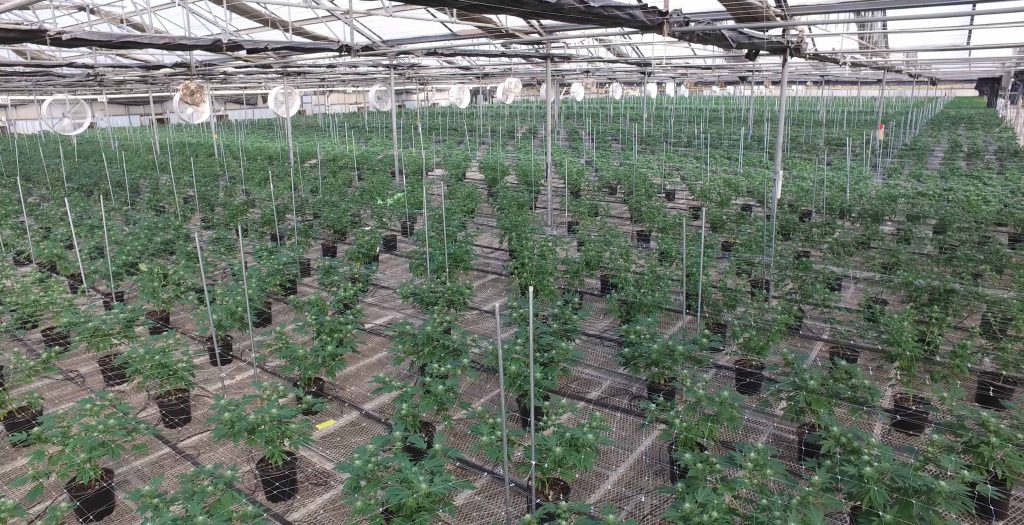
This facility also has excellent air circulation, proper trellising to keep plants stable without the need for stakes (which would increase labor cost and time), and top notch PPM/EC and pH in their irrigation. Nutrients are delivered to the plants by two separate methods: for veg, the nutrients are delivered through a top-spray nozzle system and in flower, plants are fed through a drip-feed drain-to-waste system using 4 drip meters on a timer. The systems this facility has adopted allows for a minimal run-off for maximum efficiency and immensely reduces waste.
If you’re growing in a greenhouse, however, you’re going to need some control over the lighting, especially when flipping plants from veg to flower. To solve this problem, this facility has massive light deprivation sheets to manipulate the photoperiod of plants. Huge canopies are covered with massive black tarps that induce “night” or “lights off.” This allows optimal control over the light needed to induce vegetative and flowering stages of growth at different times of the year, guaranteeing consistent all-year cannabis production. In veg rooms, this facility uses small fluorescents on top of natural light that keep plants in veg for an 18 hour light cycle, especially during shorter daylight hours during winter. A small amount of light is all these plants need to stay in veg and remain healthy and lush.
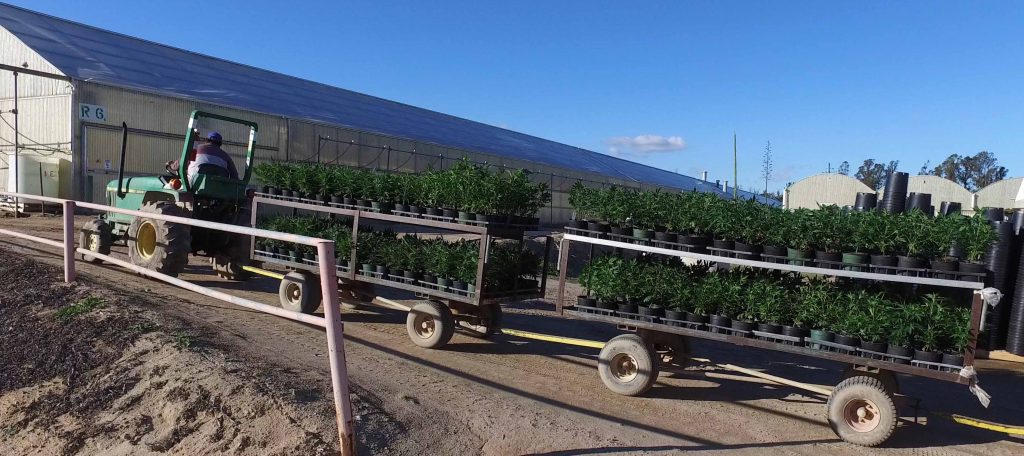
With so many plants being grown for each cycle, there has to be a lot of mums. By a lot of mums, we mean a LOT of mums. This facility has hundreds of them, kept in optimal climates to perpetuate a consistent and ideal vegetative stage that allows for healthy cuttings and consistency throughout strains.
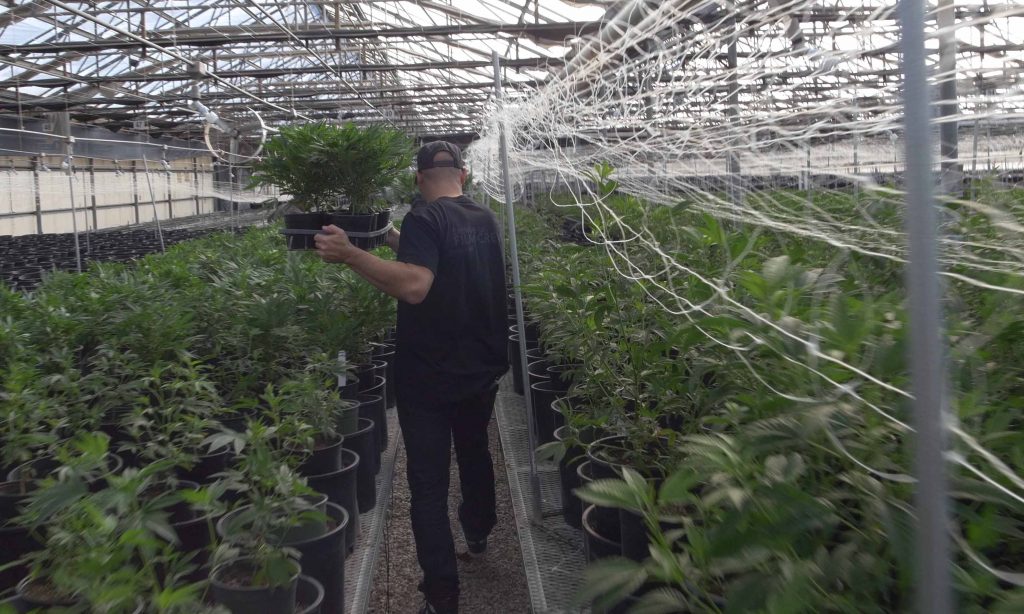
When doing cuttings, it’s crucial to ensure that your plants are kept at around 90% humidity to reduce the transpiration of water through the leaves. Most home growers can buy tiny humidity domes for cloning trays to keep their cuttings alive and well, but at a grow of this scale; you’re going to need a better method than tiny humidity domes for cloning trays. That is where the humidity room comes in.
This facility has a massive humidity room that is kept at a constant 90% humidity for thousands of babies. Cuttings thrive in a high-humidity environment, as without the humidity to stop transpiration, cuttings will dry out, wilt and die. Justin shares the best method of doing a proper cutting:
“Take the fastest growing tip off the plant, also the area where the auxin hormone is most present, and cut it off at a 45-degree angle. Dip the area you cut in a rooting solution and put it in a rooting medium such as Oasis, Rockwool, Peat, Rapid Rooters, or any type of cloning medium you prefer. Once roots come out of the medium, the clone is ready to transplant into a larger pot and go into veg. We grow for however high we want, to reach desired size, and then we determine how much that plant will flip. This determines how much size it will get in flower. If I want to finish at 4 feet tall, I veg for 2 – 2 ½ feet tall, flip into flower with a 12-hour photoperiod, and wait for final production. Once flowers fill out at about 4 feet, it’s ready for harvest.”
When your clones are ready to flip into veg, certainly a little help is needed in transplanting. This facility uses a tool more akin to farms than to grow-operations: a John Deere tractor. These tractors pull tons of plants on multi-level tractors, taking plants to transplant rooms to bring to veg and to flower.
When in flower, Andrew from GeoPot takes over to explain how this grow operation benefits from fabric pots in flower, and why they’re better than traditional pots for root aeration. Flowering plants are spaced out to maximize light coverage, which reduces the amount of “popcorn” buds on plants. The plants are quadruple trellised for optimal support and planted in 65-gallon Squat GeoPots, with 2-3 plants per pot in King’s Mix medium from Royal Gold, a high-quality and trusted quality-controlled potting mix. The nutrient solution is fed into the plants using a dripping irrigation system through four separate drips, and subthermal heat mats keep roots warm during the winter season. The benefit of the Squat Pots is that not only are they shorter, but they allow for more top production which is beneficial to growing cannabis for consumption, as tops are what the grower wants. The fabric is durable, with marine-grade stitching, and allows for aeration to the roots for extremely healthy, happy plants.
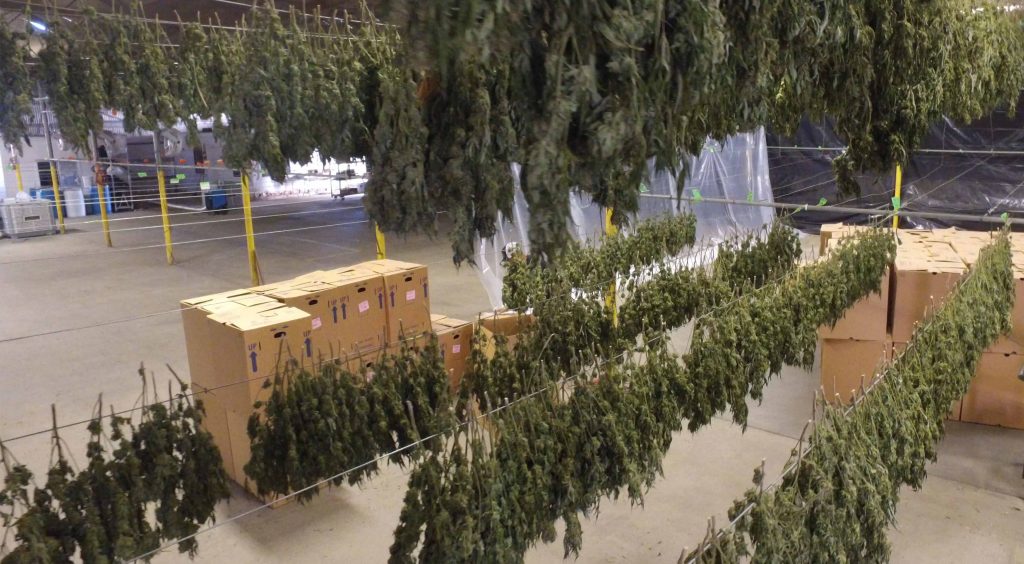
When these plants are harvested, boxes and boxes of cannabis are hung to dry and trimmed. All the cannabis grown at this facility is put through CO2 extraction to produce very clean medicine for medical users.
With such a large-scale facility, a greenhouse is the best solution for quality cannabis production. It would be impossible to control the environmental impact of a similar size indoor facility, especially considering the amount of energy needed to maintain lighting and climate control. David Robinson, the author of The Grower’s Handbook, gives us some insight on the positive environmental impact of greenhouses for large-scale cannabis production over indoor facilities:
“Greenhouses are the most efficient and environmentally friendly way to produce cannabis,” says David. “Indoors uses HID lighting, where the bulbs end up in landfills. Many don’t know, but HID bulbs contain mercury, so a fair amount of toxic waste is produced with the indoor production of cannabis. Outdoors in greenhouses, not only are we able to reclaim water through gutter systems, but we’re also benefiting from indoor climate control. We’re able to create super-consistent environments, creating optimal lights on/off temperatures and optimal humidity levels. Greenhouses allow the production of the highest quality materials possible and are also able to protect plants from outdoor problems, such as rain, heavy winds, and hail, reduce the introduction of pests, fungi and harmful pollen into your environment.”
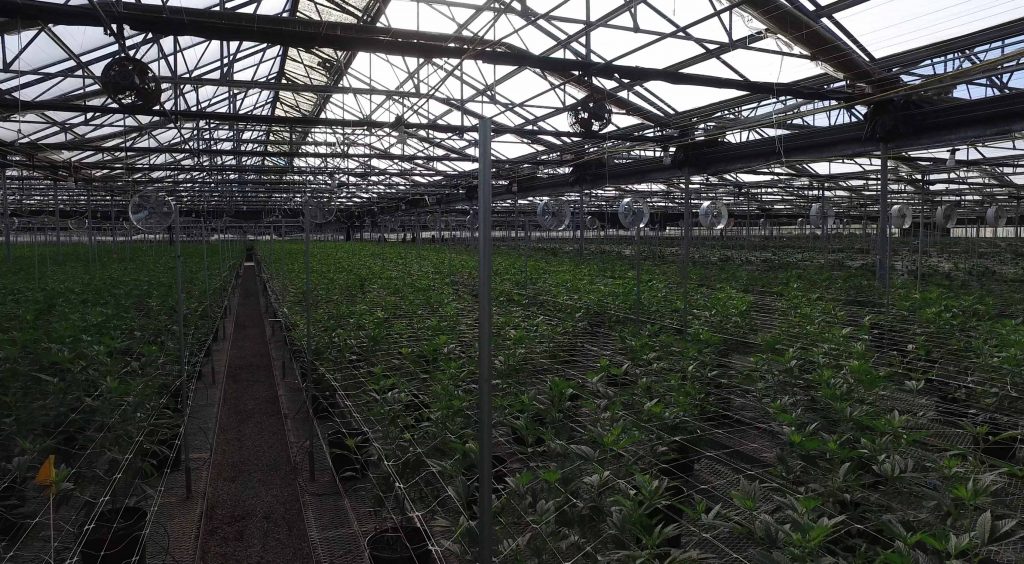
In this episode of Growing Exposed, we looked at a massive top-notch greenhouse production facility. We learned why humidity is so incredibly important for healthy clones and why greenhouses are the future of large-scale medicinal cannabis production and the benefits of this method on the environment. For more Growing Exposed, and for behind-the-scenes, tune in at GrowingExposed.com and make sure to follow Growing Exposed on Facebook and Instagram.


